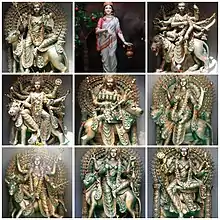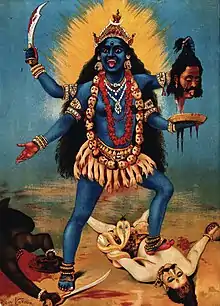Navadurga
Navadurga or Nabadurga (Sanskrit: नवदुर्गा, IAST: Navadurgā, lit. Nine forms of Durga), are nine manifestations of the goddess Durga in Hinduism, especially worshipped during the festival of Navratri where each of the nine manifested forms are venerated respectively for each night. The nine forms of Goddess Durga are: Shailaputri, Brahmacharini, Chandraghanta, Kushmanda, Skandamata, Katyayani, Kaalratri, Mahagauri and Siddhidhatri.
| Navadurga | |
|---|---|
 Collage of the Navadurga | |
| Devanagari | नवदुर्गा |
| Sanskrit transliteration | Navdurgā |
| Affiliation | Durga, Devi, Parvati |
| Mantra | Om Sarva Mangala Māngalye, Shive Sarvārtha Sādhike, Sharanye Tryambake Gauri, Nārāyani Namostute. सर्व मंगला मंगलमय, शिवाय सर्वार्थ साधिका, शरण्ये त्र्यम्बके गौरी, नारायणी नमोस्तुते |
| Mount | Lion, Tiger, Donkey or Bull |
| Festivals | Navratri, Dussehra, Durga Puja, Durga Ashtami |
| Consort | Shiva |
Forms
Each manifestation of Durga is known by her respective name, governing planet, iconography, mantra for invocation (usually repeated 108 times at each sitting during the period of Navratri), dedication day for Navratri and respective prayers.
1. Shailaputri
- Etymology: Shailaputri literally means the daughter (putri) of the mountain (shaila)
- About: After performing self-immolation in her form as Sati, the Mother Goddess took birth in the house of the King of Mountains, as the daughter of Lord Himalaya. Also known as Sati, Bhavani, Parvati or Hemavati, she is the absolute form of Mother Nature and the embodiment of the power of Brahma, Vishnu and Mahadeva.[1]
- Day of worship: 1st day of Navratri
- Governing planet: Moon
- Mantra: Oṃ Devī Śailaputryai Namaḥ ॐ देवी शैलपुत्र्यै नमः
- Iconography: Devi Shailaputri is depicted with two hands and has a crescent moon on her forehead. She holds a trident in her right hand & a lotus flower in the left. She rides on Nandi (bull).[2]
2. Brahmacharini
- Etymology:"Brahma" means "the one self-existent Spirit, the Absolute Reality, Universal Self, Personal God, the sacred knowledge". "Charini" means "occupation with, engaging, proceeding, behaviour, conduct, to follow, moving within, going after". She is the goddess of asceticism and penance, as her name is the female equivalent of one who practices Brahmacharya.
- About: Brahmacharini is the Mother Goddess born unto Prajapati Daksha as his daughter Sati and later married Shiva. This is her unmarried form. Her other names are Parvati, Aparna, Uma, Patlabati.
- Day of worship: 2nd day of Navratri
- Governing planet: Mars
- Mantra: Oṃ Devī Brahmacāriṇyai Namaḥ ॐ देवी ब्रह्मचारिण्यै नम:
- Iconography: Walks on bare feet, carrying a japa mala in Her right hand and a kamandalu in Her left hand.
3. Chandraghanta
- Etymology: Chandraghanta is made up of the words chandra meaning moon and ghanta meaning bell
- About: Chandraghanta is a powerful form of the Mother Goddess. She adorns her forehead with a half moon shaped like a bell, which explains the origin of her name. She is the goddess who inspires courage in a person and is always ready for war against demons. When provoked, she can be malevolent to those who invite her wrath, but she remains the embodiment of serenity to her followers.
- Day of worship: 3rd day of Navratri
- Governing planet: Venus
- Mantra: Oṃ Devī Candraghaṇṭāyai Namaḥ ॐ देवी चन्द्रघण्टायै नम:
- Iconography: Goddess Chandraghanta mounts the tigress. She wears the semi-circular moon(Chandra) on her forehead. The half-moon on her forehead looks like the bell(Ghanta) and hence, Her name. She is depicted with ten hands. Goddess Chandraghanta carries Trishul, Gada, sword and kamandalu in Her four left hands and keeps the fifth left hand in Varadamudra. She carries a lotus flower, arrow, Dhanush and Japa Mala in Her four right hands and keeps the fifth right hand in Abhaya Mudra.
- Powers: This form of the Mother Goddess is ready for war with all her weapons, to protect the peace and welfare of Her devotees. It is believed that the sound of the moon-bell on her forehead drives all types of evil away from Her devotees.
4. Kushmanda
- Etymology: Ku means "a little", Ushma means "warmth" or "energy" and Anda taken from the last three words of the Sanskrit word “Brahmand“ that means|The Universe]].
- About: After taking the form of Siddhidatri, the Mother Goddess began to live inside the Sun, resulting in liberation of the Sun's energy to the universe. Since then, this form of the Goddess has been known as Kushmanda, namely for her power and capability to live inside the Sun. The glow and radiance of her body is as luminous as that of the Sun.
- Day of worship: 4th day of Navratri
- Governing planet: Sun
- Mantra: Oṃ Devī Kūṣmāṇḍāyai Namaḥ ॐ देवी कूष्माण्डायै नम:
- Iconography: Rides on a lioness and has eight hands. She holds a kamandalu, Dhanush, Bada and Kamal in Her right hands. Her left hands hold Amrit Kalash(pot of nectar), japa mala(prayer beads), Gada and Chakra - in that order.
- Powers: She created the universe in the flash of Her smile and is believed to bestow siddhis (supernatural powers) and nidhis(wealth) to her devotees.She is the avatar of Goddess Parvati.
5. Skandamata
- About: Mother of the war god Skanda(Kartikeya).
- Day of worship: 5th day of Navratri
- Governing planet: Mercury
- Mantra: Oṃ Devī Skandamātāyai Namaḥ ॐ देवी स्कन्दमातायै नम:
- Iconography: Goddess Skandamata mounts the ferocious lion. She is also recognized as "The Goddess of Fire" She carries baby Skanda in her lap. Lord Skanda(also known as Kartikeya or Lord Murugan) is the brother of Ganesha. Goddess Skandamata is depicted with four hands. She carries lotus flowers in Her upper two hands. She holds baby Skanda in right hand and keeps the left hand in Abhayamudra. She sits on a lotus flower and because of that, is also known as Goddess Padmasana.
- Powers: Devotees who worship this form of the Mother Goddess get the added benefit of blessings of Lord Skanda, the God of War (also known as Kartikeya).
6. Katyayani
- About: To destroy the demon Mahishasura, Parvati incarnated as the daughter of sage Katyayana , and help the devas. She is known for her anger, vengeance and ultimate victory over the demons. She will bestow boons upon those who worship and revere her with a pure heart if she is pleased.
- Day of worship: 6th day of Navratri
- Governing planet: Jupiter
- Mantra: Oṃ Devī Kātyāyanyai Namaḥ ॐ देवी कात्यायन्यै नम:
- Iconography: Goddess Katyayani rides on a magnificent lion and is depicted with four hands. She carries a lotus flower and sword in her left hands respectively and keeps her right hands in Abhayamudra and Varadamudras.
7. Kalaratri
- About: This is the fiercest and the most ferocious form of the Mother Goddess, in which Parvati manifests to destroy the demons Sumbha and Nisumbha. Kalaratri, meaning the night of death (death night). All time, light, emotions, life forms and others all blend into her. She is the death of time and is greater than Kala (time) himself.
- Day of worship: 7th day of Navratri
- Governing planet: Saturn
- Mantra: Oṃ Devī Kālarātryai Namaḥ ॐ देवी कालरात्र्यै नम:
- Iconography: Her complexion is dark black and She rides on a donkey. She is depicted with four hands. Her right hands are in Abhayamudra and Varadamudra. She carries a sword and deadly iron hook in her left hands.
8. Mahagauri
Mahagauri is known as the goddess of purity and cleanliness. The man who pleases her, by her grace, all of his flaws, faults and mistakes will be burnt to ashes and he will be redeemed.
- About: Due to her extremely fair complexion, she was known as Mahagauri.
- Day of worship: 8th day of Navaratri
- Governing planet: Rahu
- Mantra: Om Devi Mahagauryai Namah ॐ देवी महागौर्यै नम
- Iconography: She rides the bull, just like Goddess Shailaputri. She has four arms, holding a Trishula in one of her right hands and depicts the Abhayamudra with the other right hand. She carries a tambourine or Damaru in one left hand and depicts the Varadamudra or kamandalu in her other left hand.
- Powers: She is known as the forgiving goddess and forgives sinners and purifies them.
9. Siddhidhatri
Siddhidhatri is the one who removes ignorance and she provides the knowledge to realize true reality. The Siddhi that she provides is the realization that only she exists. She is the mistress of all achievements.
- About: In the beginning of the universe, Lord Shiva worshiped the unmanifest form of the Mother Goddess, Adi Parashakti for creation. As Adi Parashakti, the Mother Goddess had no form, she thus appeared as Siddhidatri and from the left half of Lord Shiva. It is said that Siddhidatri originated from the form of Ardhanarishvara.
- Day of worship: 9th day of Navratri
- Governing planet: Ketu
- Mantra: Om Devi Siddhidatryai Namah ॐ देवी सिद्धिदात्र्यै नम
- Iconography: Goddess Siddhidatri sits on a lotus or rides on a tiger or lion. She is depicted with four hands. She has gada in the one right hand, a chakram in the other right hand, a lotus flower in the left hand and a shankha in the other left hand.
- Powers: She bestows all types of siddhi (supernatural powers) to her devotees and hence is worshipped by humans, ghandarvas, asuras and devas alike.
See also
References
- "How Goddess Shailaputri teaches us patience and strength". Times of India. 1 October 2016.
- "Shailputri on drikpanchang". drikpanchang. Retrieved 21 September 2017.
- Dictionary of Hindu Lore and Legend (ISBN 0-500-51088-1) by Anna Dhallapiccola

